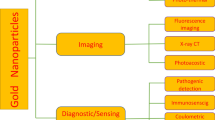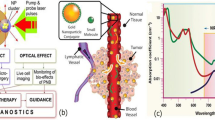Abstract
In this article, gold nanoparticles <5 nm, coated with two different natural ligand; Bovine Serum Albumin (BSA) and Glutathione (GSH) was applied in cancer treatment, by exploiting the physiochemical properties of them (size, surface charge and the chemistry of the coating ligand). Gold nanoparticles were prepared and characterized using Transmission Electron Microscopy (TEM), Dynamic Light Scattering (DLS), Zeta potential, and UV–Vis spectrophotometer. The nano-complex (BSA-AuNPs and GSH-AuNPs) was applied against Rhabdomyosarcoma (RD) cancer and Lymphocytosis normal cell lines, in vitro. The cytotoxicity effect of the complex was evaluated by MTT assay, after cells incubation with different concentrations (0.125, 0.25, 0.5, 1 mg/ml), for 24 and 48 h. The results demonstrated that the smaller sized GSH-AuNPs (~3 nm) exhibit more selective targeting and toxicity effect in cancer cells than BSA-AuNPs (≥3 nm) at all nanoparticles concentrations, by the impact of the isoelectric point (IP) impact of GSH (~ 6) that is a near value of the pH of the cancer cell, in comparison with that of BSA (~5). Whereas no toxic effect have been investigated for normal cells. These results make the GSH-AuNPs more pH-sensitive to the acidic cancer environment. This study promises that small-sized AuNPs will act as a simple therapeutic agent for cancer diseases, targeting the deep, irregular, and complicated cancer regions of the human body, subsequently dispense the usage of laser light irradiation in photothermal therapy.

Highlights
-
Small-sized gold nanoparticles (≤5 nm) coated by two types of ligands; BSA and GSH were prepared.
-
GSH-sensitve are more pH-sensitve than BSA-AuNPs induced by its isoelectric point (IP) effect.
-
The selective targeting and accumulation of GSH- inside cancer cells is greater than BSA-AuNPs.
-
Cancer toxicity relates proportionally to AuNPs concentrations and incubation time.
-
BSA-AuNPs and GSH-AuNPs could replace other cancer treatment techniques even phototherml therapy.










Similar content being viewed by others
References
Jain S, Hirst DG, O’Sullivan JM (2012) Gold nanoparticles as novel agents for cancer therapy. Br J Radiol 85:101–113
Lu PH, Li HJ, Chang HH, Wu NL, Hung CF (2017) Gold nanoparticles induce cell death and suppress migration of melanoma cells. J Nanopart Res 19:342
Blanco E, Hsiao A, Mann AP, Landry MG, Meric-Bernstam F, Ferrari M (2011) Nanomedicine in cancer therapy: Innovative trends and prospects. Cancer Sci 102:1247–1252
AL-Jawad SMH, Taha AA, Al-Halbosiy MMF, AL-Barram LFA (2018) Synthesis and characterization of small-sized gold nanoparticles coated by bovine serum albumin (BSA) for cancer photothermal therapy. Photo Photodyn Ther 21:201–210
Tuchin VV (2015) Tissue optics and photonics: light-tissue. J Biomed Photonics & Eng 1:2
Gould T, Wang Q, Pfefer TJ (2014) Optical-thermal light-tissue interactions during photoacoustic breast imaging. Biomed Opt Express 5:832–47
Han G, Xi J (2016) Light-mediated deep-tissue theranostics. Theranostics 6:2292–2294
Capek I (2015) On biodecorated gold nanoparticles distributed within tissues and cells. J Nanomed Res 2:1–10
Huang K, Ma H, Liu J, Huo S, Kumar A, Wei T, Zhang X, Jin S, Gan Y, Wang PC, He S, Zhang X, Liang XJ (2012) Size-dependent localization and penetration of ultrasmall gold nanoparticles in cancer cells, multicellular spheroids, and tumors in vivo. ACS Nano 6:4483–4493
Favi PM, Gao M, Johana LSA, Ospina SP, Morales M, Pavon JJ, Webster TJ (2015) Shape and surface effects on the cytotoxicity of nanoparticles: gold nanospheres versus gold nanostars. J Biomed Mater Res A 103:3449–62
Wade LG (2010) Amino acids, peptides, and proteins. In: AB Hughes (ed), Organic chemistry, 7th edn. Pearson Education, Inc., Wiley-VCH, p 1153–99
Harper B, Sinche F, Wu RH, Gowrishankar M, Marquart G, Mackiewicz M, Harper SL (2014) The Impact of Surface Ligands and Synthesis Method on the Toxicity of Glutathione-Coated Gold Nanoparticles. Nanomaterials 4:355–371
Broda J, Schmid G, Simon U (2014) Size- and ligand-specific bioresponse of gold clusters and nanoparticles: challenges and perspectives. In: Mingos DMP (ed) Gold clusters, colloids and nanoparticles I. Springer International Publishing, Switzerland, p 189–242
Chevrier DM, Chatt A, Zhang P (2012) Properties and applications of proteinstabilized fluorescent gold nanoclusters: short review. J Nanophoton 6:1–17
Zhang XD, Chen J, Luo Z, Wu D, Shen X, Song SS, Sun YM, Liu PX, Zhao J, Huo S, Fan S, Fan F, Liang XJ, Xie J (2014) Enhanced Tumor Accumulation of Sub-2 nm Gold Nanoclusters for Cancer Radiation Therapy. Adv Healthc Mater 3:133–141
Brin RP, Hu M, Qian L, Lymar ES, Hainfeld JF (2008) Gold Nanoparticle Size Controlled by Polymeric Au(I) Thiolate Precursor Size. J AM CHEM SOC 130:975–982
Li C, Li D, Wan G, Xu J, Hou W (2011) Facile synthesis of concentrated gold nanoparticles with low size-distribution in water: temperature and pH controls. Nanoscale Res Lett 6:440
Zhang Z, Jia J, Lai Y, Ma Y, Weng J, Sun L (2010) Conjugating folic acid to gold nanoparticles through glutathione for targeting and detecting cancer cells. Bioorg Med Chem 18:5528–34
Lazarus GG (2014) The design and synthesis of gold nanoparticles and its interaction with mammalian cells in culture. PhD Dissertation, University of KwaZulu-Natal
Zheng J, Zhou C, Yu M, Liu J (2012) Different sized luminescent gold nanoparticles. Nanoscale 4:4073–4083
Rady HS, Emam AN, Mohamed MB, El-Shall MS (2017) Graphene Oxide Interface Enhances the Photochemical Synthesis, Stability and Photothermal Effect of Plasmonic Gold Nanostructures. Chem Phys Lett 690:153–158
Malola SA, Lehtovaara L, Enkovaara J, Hakkinen HJ (2013) Birth of the Localized Surface Plasmon Resonance in Monolayer Protected Gold Nanoclusters. ACS Nano 7:10263–10270
Iida K, Noda M, Ishimura K, Nobusada K (2014) First-Principles Computational Visualization of Localized Surface Plasmon Resonance in Gold Nanoclusters. J Phys Chem 118:11317–11322
AL-Jawad SMH (2017) Structural and optical properties of core–shell TiO2/CdS prepared by chemical bath deposition. J Electron Mater 46(10):5837–5847. https://doi.org/10.1007/s11664-017-5597-3
Venditti I (2017) Gold nanoparticles in photonic crystals applications: a review. Materials 10:1–18
Malola S, Lehtovaara L, Hakkinen H, DFT A (2014) Study of Linear Gold−Thiolate Superclusters Absorbing in the Therapeutic NIR Window. J Phys Chem Lett 5:1329–133
Mironava T, Hadjiargyrou M, Simon M, Jurukovski V, Rafailovich MH (2010) Gold nanoparticles cellular toxicity and recovery: effect of size, concentration and exposure time. Nanotoxicology 4:120–37
Yao M, He L, McClements DJ, Xiao H (2015) Uptake of Gold Nanoparticles by Intestinal Epithelial Cells: Impact of Particle Size on Their Absorption, Accumulation, and Toxicity. J Agric Food Chem 63:8044–9
Fratoddi I, Venditti I, Cametti C, Russo MV (2015) How toxic are gold nanoparticles? The state-of-the-art. Nano. Research 8:1771–1799
Hu J, Bae YH (2016) pH-Sensitive Nanosystems. In: Torchilin V (ed) Smart Pharmaceutical Nanocarriers. Imperial College Press, Northeastern University, USA, p 49–81
Pillai PP, Kowalczyk B, Grzybowski BA (2016) Self-assembly of like-charged nanoparticles into microscopic crystals. Nanoscale 8:157–161
Mizuhara T, Saha K, Moyano DF, Kim CS, Yan B, Kim YK, Rotello VM (2015) Acylsulfonamide-Functionalized Zwitterionic Gold Nanoparticles for Enhanced Cellular Uptake at Tumor pH. Angew Chem Int Ed 54:6567–70
Mura S, Nicolas J, Couvreur P (2013) Stimuli-responsive nanocarriers for drug delivery. Nat Mater 12:991–1003
Salzano G, Costa FD, Torchilin PV (2015) SiRNA delivery by stimuli-sensitive nanocarriers. Curr Pharm Des 21:4566–4573
Bischoff R, Schlüter H (2012) Amino acids: Chemistry, functionality and selected non-enzymatic post-translational modifications. J Proteom 75:2275–2296
Valino V, Roman MFS, Ibanez R, Ortiz I (2014) Improved separation of bovine serum albumin and lactoferrin mixtures using charged ultrafiltration membranes. Sep Purif Technol 125:163–169
Huo S, Jin S, Ma X, Xue X, Yang K, Kumar A, Wang PC, Zhang J, Hu Z, Liang XJ (2014) Ultrasmall gold nanoparticles as carriers for nucleus-based gene therapy due to size-dependent nuclear entry. ACS Nano 8:5852–5862
Umair M, Javed I, Rehman M, Madni A, Javeed A, Ghafoor A, Ashraf M (2016) Nanotoxicity of inert materials: The case of gold, silver and iron. J Pharm Pharm Sci 19:161–80
Oh E, Delehanty JB, Sapsford KE, Susumu K, Goswami R, Blanco-Canosa JB, Dawson PE, Granek J, Shoff M, Zhang Q, Goering PL, Huston A, Medintz IL (2011) Cellular uptake and fate of PEGylated gold nanoparticles is dependent on both cell-penetration peptides and particle size. ACS Nano 5:6434–48
Julin S, Nummelin S, Kostiainen MA, Linko V (2018) DNA nanostructure-directed assembly of metal nanoparticle superlattices. J Nanopart Res 20:119
Author information
Authors and Affiliations
Corresponding author
Ethics declarations
Conflict of interest
The authors declare that they have no conflict of interest.
Rights and permissions
About this article
Cite this article
AL-Jawad, S.M.H., Taha, A.A. & AL-Barram, L.F.A. Effective cancer treatment by targeted pH sensitive–gold nanoparticles without using laser irradiation. J Sol-Gel Sci Technol 89, 473–485 (2019). https://doi.org/10.1007/s10971-018-4832-6
Received:
Accepted:
Published:
Issue Date:
DOI: https://doi.org/10.1007/s10971-018-4832-6




